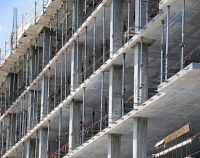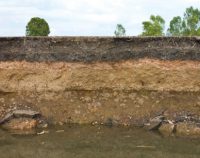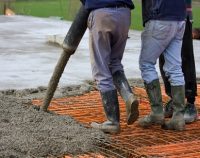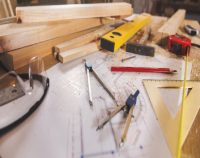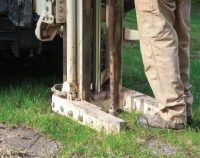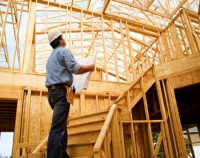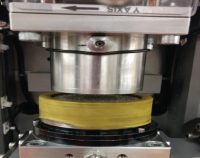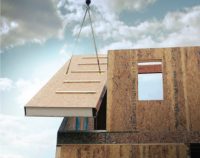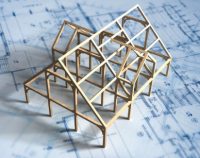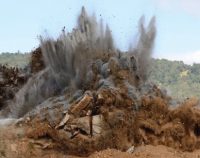Showing 21–40 of 44 results
Design of Heavy Duty Concrete Floor Slabs on Grade: 3 PDH
$18.00 Add to cartThis course describes the criteria for the design of concrete floor slabs on grade in buildings for heavy loads. Concrete floor slabs on grade are often subjected to heavy loads in buildings such as wall loads, stationary live loads and moving loads. The entire design procedure is based on a working stress concept. This course will provide the student with the criteria needed to design concrete floor slabs on grade subjected to heavy loads. Design examples are shown to aid in understanding the course material.Instructor: Raymond Bosek, PEThis course describes the criteria for the design of concrete floor slabs on grade in buildings for heavy loads. Concrete floor slabs on grade are often subjected to heavy loads in buildings such as wall loads, stationary live loads and moving loads. The entire design procedure is based on a working stress concept. This course will provide the student with the criteria needed to design concrete floor slabs on grade subjected to heavy loads. Design examples are shown to aid in understanding the course material.
SPECIFIC KNOWLEDGE OR SKILL OBTAINED
This course teaches the following specific knowledge and skills:
- The steps required to design a heavy duty concrete floor slab
- How to determine floor slab requirements for wall loads, stationary wall loads and moving loads
- How to investigate the subgrade and environmental conditions relevant to the design
- How to determine the modulus of subgrade reaction for various soils
CERTIFICATE OF COMPLETION
You will be able to immediately print a certificate of completion after passing a 15 question multiple-choice quiz. The quiz can be retaken unlimited times until a passing grade of 70% or better is earned. This course satisfies 3 professional development hours (PDH) of continuing education.
Preview CourseClick “Preview Course” to View Prior to PurchaseClick “Add to Cart” to Purchase and Access QuizDesign of Hydraulic Steel Structures: 4 PDH
$24.00 Add to cartProper design, construction, and maintenance of hydraulic steel structures (HSS) is imperative for safe operation and reliable service over the structure’s lifetime. Engineers charged with the responsibility of maintaining these structures must be familiar with the basics of HSS design, as well as the intricacies of the structure’s abilities and limitations. This 4 hour interactive course prescribes guidance for (a) designing hydraulic steel structures (HSS) by load and resistance factor design (LRFD) and (b) fracture control. Allowable stress design (ASD) guidance is provided as an alternative design procedure or for those structure types where LRFD criteria have yet to be developed.Instructor: Raymond Bosek, PEProper design, construction, and maintenance of hydraulic steel structures (HSS) is imperative for safe operation and reliable service over the structure’s lifetime. Engineers charged with the responsibility of maintaining these structures must be familiar with the basics of HSS design, as well as the intricacies of the structure’s abilities and limitations. This 4 hour interactive course prescribes guidance for (a) designing hydraulic steel structures (HSS) by load and resistance factor design (LRFD) and (b) fracture control. Allowable stress design (ASD) guidance is provided as an alternative design procedure or for those structure types where LRFD criteria have yet to be developed. Hydraulic steel structures are lock gates, tainter gates, tainter valves, bulkheads and stoplogs, vertical lift gates, components of hydroelectric and pumping plants, and miscellaneous structures such as lock wall accessories, local flood protection gates, and outlet works gates. HSS may be subject to submergence, wave action, hydraulic hammer, cavitation, impact, corrosion, and severe climatic conditions.
SPECIFIC KNOWLEDGE OR SKILL OBTAINED
This course teaches the following specific knowledge and skills:
- Discuss the benefits of the LRFD method over the ASD method of designs
- List the modes of failure for HSS and what design principles are used to address these issues
- Describe the types of HSS and their corresponding uses and allowable stress loads
- Name the different types of HSS connections, including their design specifications and appropriate uses
CERTIFICATE OF COMPLETION
You will be able to immediately print a certificate of completion after passing a 20 question multiple-choice quiz. The quiz can be retaken unlimited times until a passing grade of 70% or better is earned. This course satisfies 4 professional development hours (PDH) of continuing education.
Preview CourseClick “Preview Course” to View Prior to PurchaseClick “Add to Cart” to Purchase and Access QuizDeterioration of Concrete: 2 PDH
$12.00 Add to cartIn this course, the student will review Chapter 3, Causes of Distress and Deterioration of Concrete from Engineer Manual (EM) 1110-2-2002, “Engineering and Design – Evaluation and Repair of Concrete Structures” published by the U.S. Army Corp of Engineers (issued 30 June 1995). This course is most relevant to engineers wishing to attain knowledge on the most common causes of problems in concrete. The course also provides a brief description of the basic mechanism of each common problem, a description of the typical symptoms that would be observed during a visual inspection, and suggests preventative methods or techniques to prevent further damage.Instructor: Raymond Bosek, PEA basic understanding of the underlying causes of concrete deficiencies is essential to performing meaningful evaluations which lead to the proper selection of the method or technique used to successfully repair concrete. Symptoms or observations of a deficiency must be differentiated from the actual cause of the deficiency, and it is imperative that causes and not symptoms be addressed in repairs. Deterioration of concrete is an extremely complex subject since, in most cases, the damage detected will be the result of more than one mechanism.
In this course, the student will review Chapter 3, Causes of Distress and Deterioration of Concrete from Engineer Manual (EM) 1110-2-2002, “Engineering and Design – Evaluation and Repair of Concrete Structures” published by the U.S. Army Corp of Engineers (issued 30 June 1995). This course is most relevant to engineers wishing to attain knowledge on the most common causes of problems in concrete. The course also provides a brief description of the basic mechanism of each common problem, a description of the typical symptoms that would be observed during a visual inspection, and suggests preventative methods or techniques to prevent further damage.
SPECIFIC KNOWLEDGE OR SKILL OBTAINED
This course teaches the following specific knowledge and skills:
- Common causes of concrete deterioration
- Symptoms of concrete distress and deterioration that can be found during visual inspections
- Preventative measures to reduce or eliminate further concrete degradation.
CERTIFICATE OF COMPLETION
You will be able to immediately print a certificate of completion after passing a 10 question multiple-choice quiz. The quiz can be retaken unlimited times until a passing grade of 70% or better is earned. This course satisfies 2 professional development hours (PDH) of continuing education.
Preview CourseClick” Preview Course” to View Prior to PurchaseClick “Add to Cart” to Purchase and Access QuizEnergy Performance of LEED for New Construction Buildings: 2 PDH
$12.00 Add to cartThis course focuses on the measured energy performance for 121 LEED New Construction buildings, and compares the data to a variety of benchmarks, including Commercial Building Energy Consumption Survey (CBECS) averages, Energy Star ratings and modeled energy performance estimates provided with LEED submittals.Instructor: Raymond Bosek, PEThis focuses on the measured energy performance for 121 LEED New Construction buildings, and compares the data to a variety of benchmarks, including Commercial Building Energy Consumption Survey (CBECS) averages, Energy Star ratings and modeled energy performance estimates provided with LEED submittals.
SPECIFIC KNOWLEDGE OR SKILL OBTAINED
This course teaches the following specific knowledge and skills:
- Recognize how energy performance of the sample set of buildings was evaluated
- Understand energy savings of LEED certified buildings
- Discern the accuracy of energy models
- Discern the accuracy of building specific energy models
- Interpret the strength and weeknesses of using LEED
CERTIFICATE OF COMPLETION
You will be able to immediately print a certificate of completion after passing a 10 question multiple-choice quiz. The quiz can be retaken unlimited times until a passing grade of 70% or better is earned. This course satisfies 2 professional development hours (PDH) of continuing education.
Preview CourseClick “Preview Course” to View Prior to PurchaseClick “Add to Cart” to Purchase and Access QuizEngineer’s Guide to Corrosion-Causes, Protection and Control: 8 PDH
$40.00 Add to cartIn this course the student will understand the process of corrosion on metals from its causes and effects into protection and control. The student will understand corrosion on a variety of metals and methods to mitigate and control corrosion over the life of a material. Instructor: Seth Grablow, PESPECIFIC KNOWLEDGE OR SKILL OBTAINED
This course teaches the following specific knowledge and skills:
- Discuss environmental factors that affect corrosion
- Understand the eight major forms of corrosion
- Discuss corrosion characteristics and properties of various common metals
- Explain corrosion protection and methods of control
- Discuss monitoring of corrosion and available inspection technologies
- Understand the electrochemistry, kinetics, and thermodynamics of the corrosion process
CERTIFICATE OF COMPLETION
You will be able to immediately print a certificate of completion after passing a 30 question multiple-choice quiz. The quiz can be retaken unlimited times until a passing grade of 70% or better is earned. This course satisfies eight professional development hours (PDH) of continuing education.
Preview CourseClick “Preview Course” to View Prior to PurchaseClick “Add to Cart” to Purchase and Access QuizEngineering Description of Soils and Rocks: 4 PDH
$24.00 Add to cartIn this course the student will understand the engineering characteristics of soils and rocks and to how to properly identify and classify to develop a subsurface profile for site evaluations.Instructor: Raymond Bosek, PESPECIFIC KNOWLEDGE OR SKILL OBTAINED
This course teaches the following specific knowledge and skills:
- Discuss soil descriptions and standards
- Explain soil classification and properties
- Discuss practical aspects of fine-grained and course-grained soils
- Explain rock descriptions and classifications (SPT)
- Understand subsurface profile development
CERTIFICATE OF COMPLETION
You will be able to immediately print a certificate of completion after passing a 20 question multiple-choice quiz. The quiz can be retaken unlimited times until a passing grade of 70% or better is earned. This course satisfies four (4) hours of professional development (PDH).
Preview CourseClick “Preview Course” to view prior to purchaseClick “Add to Cart” to purchaseFoundations in Expansive Soils: 6 PDH
$36.00 Add to cartThis course presents guidance and information for the geotechnical investigation necessary for the selection and design of foundations for heavy and light buildings constructed in expansive clay soil areas. The information in this course is generally applicable to many types of structures such as residences, warehouses, and multi-story buildings. Emphasis is given to the maintenance of an environment that encourages constant moisture conditions in the foundation soils during and following construction. Special attention must always be given to specific requirements of the structure such as limitations on allowable differential movement.Instructor: Raymond Bosek, PEThis course presents guidance and information for the geotechnical investigation necessary for the selection and design of foundations for heavy and light buildings constructed in expansive clay soil areas. The information in this course is generally applicable to many types of structures such as residences, warehouses, and multi-story buildings. Emphasis is given to the maintenance of an environment that encourages constant moisture conditions in the foundation soils during and following construction. Special attention must always be given to specific requirements of the structure such as limitations on allowable differential movement.
SPECIFIC KNOWLEDGE OR SKILL OBTAINED
This course teaches the following specific knowledge and skills:
- Guidelines of the geotechnical investigation and analysis
- Field exploration
- Laboratory investigations
- Methodology for prediction of volume changes
- Selection of the type of foundation
- Structural details of design procedures provided for reference
- Methods of minimizing foundation movement
- Construction techniques and inspection
Remedial repair of damaged structures
CERTIFICATE OF COMPLETION
You will be able to immediately print a certificate of completion after passing a 20 question multiple-choice quiz. The quiz can be retaken unlimited times until a passing grade of 70% or better is earned. This course satisfies 6 professional development hours (PDH) of continuing education.
Preview CourseClick “Preview Course” to View Prior to PurchaseClick “Add to Cart” to Purchase and Access QuizFundamentals of Metals: 5 PDH
$30.00 Add to cartThe course provides an understanding of the structure and properties of metals, stress mechanisms, failure modes and the characteristics determine their usefulness for a specific application. Often, materials are subject to variable forces (loads). The engineer calculates these forces to establish the service that can be expected and material scientists experiment to determine how materials deform (elongate, compress, and twist) or break as a function of applied load, time, temperature, and other conditions.Instructor: Seth Grablow, PEThe course provides an understanding of the structure and properties of metals, stress mechanisms, failure modes and the characteristics determine their usefulness for a specific application. Often, materials are subject to variable forces (loads). The engineer calculates these forces to establish the service that can be expected and material scientists experiment to determine how materials deform (elongate, compress, and twist) or break as a function of applied load, time, temperature, and other conditions.
SPECIFIC KNOWLEDGE OR SKILL OBTAINED
This course teaches the following specific knowledge and skills:
- Mechanical properties of metals
- Structure of metals and how those structures are affected by various processes
CERTIFICATE OF COMPLETION
You will be able to immediately print a certificate of completion after passing a 20 question multiple-choice quiz. The quiz can be retaken unlimited times until a passing grade of 70% or better is earned. This course satisfies 5 professional development hours (PDH) of continuing education.
Preview CourseClick “Preview Course” to View Prior to PurchaseClick “Add to Cart” to Purchase and Access QuizFundamentals of Wood Construction: 3 PDH
$18.00 Add to cartIn this course the student will understand the basics of wood in construction including common woodworking techniques for construction.This course is designed to bridge the gap in knowledge between engineers & building trade professionals.Instructor: Raymond Bosek, PESPECIFIC KNOWLEDGE OR SKILL OBTAINED
This course teaches the following specific knowledge and skills:
- Describe the types, sources, uses, and characteristics of the common woods used on various construction projects
- Explain the various methods and joints associated with woodworking
- Identify the different types of fastening devices
- Identify common trade terms
CERTIFICATE OF COMPLETION
You will be able to immediately print a certificate of completion after passing a 15 question multiple-choice quiz. The quiz can be retaken unlimited times until a passing grade of 70% or better is earned. This course satisfies 3 professional development hours (PDH) of continuing education.
Preview CourseClick “Preview Course” to View Prior to PurchaseClick “Add to Cart” to Purchase and Access QuizGeotechnical Subsurface Exploration for Roadways: 5 PDH
$30.00 Add to cartIn this course the student will understand the essentials of subsurface explorations for roadways with a comprehensive overview including site preparation, sampling methods, types of testing and methods, as well as standard guidelines and recommendations.Instructor: Raymond Bosek, PESPECIFIC KNOWLEDGE OR SKILL OBTAINED
This course teaches the following specific knowledge and skills:
- Discuss preparing for subsurface explorations
- Explain field reconnaissance and setting-up a exploration program
- Discuss sampling techniques and tools
- Explain various tests in addition to the standard penetration test (SPT)
- Understand guidelines for minimum exploration
CERTIFICATE OF COMPLETION
You will be able to immediately print a certificate of completion after passing a 20 question multiple-choice quiz. The quiz can be retaken unlimited times until a passing grade of 70% or better is earned. This course satisfies five (5) hours of professional development (PDH).
Preview CourseClick “Preview Course” to view prior to purchaseClick “Add to Cart” to purchaseHome Builders Guide to Earthquake Resistant Building Design: 5 PDH
$30.00 Add to cartIn this course, the student will review Chapters 1-4 from “Homebuilders Guide to Earthquake Resistant Design and Construction”, FEMA 232 – June 2006 prepared by the Building Seismic Safety Council for the Federal Emergency Management Agency of the Department of Homeland Security.
The student must take a multiple-choice quiz consisting of twenty (20) questions at the end of this course to earn PDH credits.Instructor: Raymond Bosek, PEThe purpose of this course is to familiarize the engineer with the basic principles of earthquake-resistant design for residential construction. Adequate construction is required in order for a structure to fair well during and after an earthquake. This course will cover the general earthquake-resistance requirements in the International Residential Code, IRC, and requirements for foundation and floor construction.In this course, the student will review Chapters 1-4 from “Homebuilders Guide to Earthquake Resistant Design and Construction”, FEMA 232 – June 2006 prepared by the Building Seismic Safety Council for the Federal Emergency Management Agency of the Department of Homeland Security.
The student must take a multiple-choice quiz consisting of twenty (20) questions at the end of this course to earn PDH credits.
SPECIFIC KNOWLEDGE OR SKILL OBTAINED
This course teaches the following specific knowledge and skills:
- Background & History
- Above-Code Recommendations
- International Residential Code & IRC Seismic Design Categories
- Building Response & Concepts Concerning Site
- Other Hazards including Coastal Hazards
- Earthquake Resistant Requirements
- IRC General Earthquake Limitations
- Load Path
- Lateral Capacities
- House Configuration Irregularities
- Foundation Requirements including Concrete Foundations & Masonry Foundations
- Special Soil Conditions
- Foundation Resistance to Sliding Loads
- Special Considerations for Cut & Fill Sites
- Foundation Design and Reinforcement
- Interior Braced Walls Anchoring
- Floor Design & Construction including Wood Frame, Cantilevered & Concrete Slab-On-Grade
- Requirements for Blocking
- Floor Sheathing
CERTIFICATE OF COMPLETION
You will be able to immediately print a certificate of completion after passing a 20 question multiple-choice quiz. The quiz can be retaken unlimited times until a passing grade of 70% or better is earned. This course satisfies 5 professional development hours (PDH) of continuing education.
Preview CourseClick Preview Course to View Prior to PurchaseClick “Add to Cart” to Purchase and Access QuizHurricane Mitigation: Summary Report On Building Performance: 3 PDH
$18.00 Add to cartAfter major hurricane disasters, the Federal Emergency Management Agency (FEMA) dispatches Building Performance Assessment Teams (BPATs) to evaluate the successes and failures of buildings to withstand the wind and flood forces of these storms. The teams document the results of their evaluations in building performance assessment reports. This 3-hour online course summarizes the BPAT reports for Hurricane Katerina.Instructor: Raymond Bosek, PEAfter major hurricane disasters, the Federal Emergency Management Agency (FEMA) dispatches Building Performance Assessment Teams (BPATs) to evaluate the successes and failures of buildings to withstand the wind and flood forces of these storms. The teams document the results of their evaluations in building performance assessment reports. This 3-hour online course summarizes the BPAT reports for Hurricane Katerina.
SPECIFIC KNOWLEDGE OR SKILL OBTAINED
This course teaches the following specific knowledge and skills:
- Describe the building and foundation types typically used in coastal areas
- Illustrate the ability of various building and foundation types to withstand coastal surge, riverine flood, and hurricane winds
- Explain design and construction practices that can reduce building damage in hurricanes
- Describe construction practices that can reduce building damage in hurricanes
CERTIFICATE OF COMPLETION
You will be able to immediately print a certificate of completion after passing a 15 question multiple-choice quiz. The quiz can be retaken unlimited times until a passing grade of 70% or better is earned. This course satisfies 3 professional development hours (PDH) of continuing education.
Preview CourseClick “Preview Course” to View Prior to PurchaseClick “Add to Cart” to Purchase and Access QuizImproving Energy Efficiency in Historic Buildings: 2 PDH
$12.00 Add to cartIn this course the student will learn the general concept of the most efficient methods to enhance energy efficiency of historic buildings, while limiting the damage done during the rehabilitation process.Instructor: Raymond Bosek, PEIn this course the student will learn the general concept of the most efficient methods to enhance energy efficiency of historic buildings, while limiting the damage done during the rehabilitation process.SPECIFIC KNOWLEDGE OR SKILL OBTAINED
This course teaches the following specific knowledge and skills:
- Inherent energy efficient features of historic buildings
- Concept of conducting an energy audit
- Actions to improve energy efficiency
- Dealing with moisture
- Applicable alternative energy sources
CERTIFICATE OF COMPLETION
You will be able to immediately print a certificate of completion after passing a 10 question multiple-choice quiz. The quiz can be retaken unlimited times until a passing grade of 70% or better is earned. This course satisfies two (2) professional development hours (PDH) of continuing education.
Preview CourseClick “Preview Course” to View Prior to PurchaseClick “Add to Cart” to Purchase and Access QuizInnovative Building Technology: 5 PDH
$30.00 Add to cartIn this course the student will understand the design process of building and constructing modern innovative buildings using new technology products and methods to increase building efficiency, durability, and sustainability. Instructor: Raymond Bosek, PESPECIFIC KNOWLEDGE OR SKILL OBTAINED
This course teaches the following specific knowledge and skills:
- Discuss the four decision phases for any project
- Understand the economics of implementing new technologies into the design and construction
- Discuss cost/benefits into the decision making process
- Explain feasibility by performance and economics
- Discuss performance measures through design and construction
- Understand building efficiency, durability, and sustainability
- Become familiar with the evaluation tools and resources available during design and construction
CERTIFICATE OF COMPLETION
You will be able to immediately print a certificate of completion after passing a 20 question multiple-choice quiz. The quiz can be retaken unlimited times until a passing grade of 70% or better is earned. This course satisfies five professional development hours (PDH) of continuing education.
Preview CourseClick “Preview Course” to View Prior to PurchaseClick “Add to Cart” to Purchase and Access QuizInternal Curing for Concrete Pavements: 1 PDH
$6.00 Add to cartIn this course the student will understand the concepts and benefits of internal curing for concrete pavements including mixture design, quality control, and studies of practical applications over the past two decades.Instructor: Raymond Bosek, PEIn this course the student will understand the concepts and benefits of internal curing for concrete pavements including mixture design, quality control, and studies of practical applications over the past two decades.SPECIFIC KNOWLEDGE OR SKILL OBTAINED
This course teaches the following specific knowledge and skills:
- Internally cured concrete pavement applications
- Mixture design
- Construction aspects
- Properties of internally cured concrete
- Practical applications
CERTIFICATE OF COMPLETION
You will be able to immediately print a certificate of completion after passing a 10 question multiple-choice quiz. The quiz can be retaken unlimited times until a passing grade of 70% or better is earned. This course satisfies one (1) professional development hour (PDH) of continuing education.
Preview CourseClick “Preview Course” to View Prior to PurchaseClick “Add to Cart” to Purchase and Access QuizLaboratory Testing for Geotechnical Design and Construction: 5 PDH
$30.00 Add to cartIn this course the student will understand the intricate details of laboratory testing of subsurface soils and rocks in order to obtain values of their engineering properties necessary for design.Instructor: Raymond Bosek, PESPECIFIC KNOWLEDGE OR SKILL OBTAINED
This course teaches the following specific knowledge and skills:
- Explain common laboratory test methods
- Discuss laboratory testing equipment for soil and rock samples
- Discuss testing procedures
- Explain measured parameters
- Understand common guidelines for testing soils and rocks
CERTIFICATE OF COMPLETION
You will be able to immediately print a certificate of completion after passing a 20 question multiple-choice quiz. The quiz can be retaken unlimited times until a passing grade of 70% or better is earned. This course satisfies five (5) hours of professional development (PDH).
Preview CourseClick “Preview Course” to view prior to purchaseClick “Add to Cart” to purchaseLessons Learned-Design and Construction of Buildings: 3 PDH
$18.00 Add to cartIn this course the student will review lessons learned from post building occupancy evaluations to understand common building design and/or construction flaws and review essential tips to correct, avoid and/or mitigate these occurrences.Instructor: Raymond Bosek, PESPECIFIC KNOWLEDGE OR SKILL OBTAINED
This course teaches the following specific knowledge and skills:
- Explain overall building design and construction best practices
- Discuss general building site and landscape guidelines
- Discuss envelope/structure essential tips
- Understand architecture/interiors best practices
- Describe mechanical/plumbing lessons learned
- Explain lighting/electrical essentail tips
- Explain operational fundamentals as relates to accessibility, durability, reliability, and maintainability/cleanability
CERTIFICATE OF COMPLETION
You will be able to immediately print a certificate of completion after passing a 15 question multiple-choice quiz. The quiz can be retaken unlimited times until a passing grade of 70% or better is earned. This course satisfies three (3) hours of professional development (PDH).
Preview CourseClick “Preview Course” to view prior to purchaseClick “Add to Cart” to purchasePrescriptive Method for Structural Insulated Panels (SIPs) in Construction: 3 PDH
$18.00 Add to cartIn this course the student will learn prescriptive requirements to facilitate the use of Structural Insulated Panels (SIPs) in wall systems for the construction of one- and two-family dwellings. Instructor: Raymond Bosek, PESPECIFIC KNOWLEDGE OR SKILL OBTAINED
This course teaches the following specific knowledge and skills:
- Explain SIP materials, shapes, & standard sizes
- Understand prescriptive provisions for wall thickness selection
- Discuss Above grade wall requirements
- Discuss SIP header & connection details
- Explain construction details to design and construct residential wall systems using SIPs
CERTIFICATE OF COMPLETION
You will be able to immediately print a certificate of completion after passing a 15 question multiple-choice quiz. The quiz can be retaken unlimited times until a passing grade of 70% or better is earned. This course satisfies three professional development hours (PDH) of continuing education.
Preview CourseClick “Preview Course” to View Prior to PurchaseClick “Add to Cart” to Purchase and Access QuizResidential Structural Design: 5 PDH
$30.00 Add to cartIn this course the student will understand the basics of residential construction and design, residential structural design concepts and design loads for residential buildings and to gain an understanding of modern design methods and concepts for light-frame homes, apartments, and townhouses.Instructor: Raymond Bosek, PESPECIFIC KNOWLEDGE OR SKILL OBTAINED
This course teaches the following specific knowledge and skills:
- Explain American housing relative to its history, construction characteristics, regulation, and performance experience
- Discuss structural sesign as it applies to residential buildings
- Discuss the latest technical knowledge and engineering approaches for the design of homes
- Explain design loads for residential buildings
- Explain the various loads and load combinations
- Review the various design approaches and corresponding calculations
CERTIFICATE OF COMPLETION
You will be able to immediately print a certificate of completion after passing a 20 question multiple-choice quiz. The quiz can be retaken unlimited times until a passing grade of 70% or better is earned. This course satisfies five (5) hours of professional development (PDH).
Preview CourseClick “Preview Course” to view prior to purchaseClick “Add to Cart” to purchaseRock Excavations Blasting Design Part 1: 6 PDH
$36.00 Add to cartIn this course the student will understand the fundamentals of blasting for rock excavations by learning the art and design of using explosives for the removal of rock and similar materials for construction activities. This is part 1 of a 2 part series.Instructor: Raymond Bosek, PESPECIFIC KNOWLEDGE OR SKILL OBTAINED
This course teaches the following specific knowledge and skills:
- Discuss the history of explosives in construction
- Identify basic blasting terminology
- Explain the different types of explosives
- Determine optimal explosives for use cases
- Discuss the various types of initiation systems
- Discuss common geology encountered and blast design characteristics
- Explain site exploration activities and common hazards
CERTIFICATE OF COMPLETION
You will be able to immediately print a certificate of completion after passing a 20 question multiple-choice quiz. The quiz can be retaken unlimited times until a passing grade of 70% or better is earned. This course satisfies 6 professional development hours (PDH) of continuing education.
Preview CourseClick “Preview Course” to View Prior to PurchaseClick “Add to Cart” to Purchase and Access Quiz

